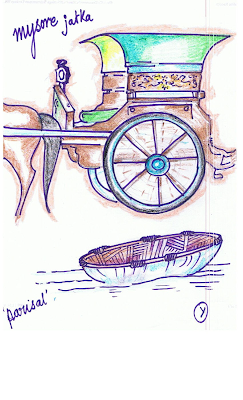TONLE SAP - Life on Water

As the motorboat tore through the water, it seemed like we were traversing an ocean. A vast sheet of blue-grey water, churning and rippling in response to the busy boat traffic. 18,000Sq.Km. to be precise.
Its hard to believe that Tonle Sap is a really a lake.
The lakes of my acquaintance are modest troughs, mostly the ornamental types that house a fountain or a leisure-boating facility. Had seen nothing like Tonle Sap . It was a revelation.

As our boat slowed down to negotiate a turn near some greenery, i discovered that the green patches were actually treetops ! Now that was unreal !
'You mean trees grow underwater out here ? Or is this ocean just a mega size puddle left over from the rains ? Those trees must be at least 10 meters tall , but only their crowns are showing !'
The guide reminded us that it was the Wet Season. The season of the Reverse Flow. When water, instead of emptying into the Mekong river , backs up into the "floodplain" becoming the largest freshwater lake in South east Asia. During the Dry Season, the vast lake will pour itself into the river, shrinking to a fraction of the size presently seen. Just about a measly 2500 sq.km. and barely a meter deep.
Tonle Sap, the huge fresh water body found in Cambodia, is a most unusual lake, designated by UNESCO as a precious Biosphere Reserve. The constant expanding and shrinking has given rise to an interesting pattern of aqualife and sedimentation, rich in biodiversity. It has also supported a curious form of semi nomadic human settlements since ancient times. As it yields 75% of Cambodia's freshwater fish, around 4 million people live as its dependents.

Cruising along, we passed by Tonle Sap's floating villages with their floating houses, floating schools, floating churches, floating cafes, floating shops, floating saloons, floating pigstys , floating crocodile farms,floating garbage heaps. And floating Souvenir Shops for tourists ! Everything packs up and shifts twice a year. The villagers know no other life. They move with the water as it swells or recedes. The only permanent part of the address is "Tonle Sap "!

Little kids row around in plastic or aluminium tubs with their pets. They seem to learn floating skills as soon as they learn to walk.
The ethnic groups that live on the lake are mainly Vietnamese or the Cham. Life is hard and people are permanently in want. Yet, they prefer to float than to migrate to terra firma.
We learnt from the guide that while most dwellings are built as boathouses, a few who can be considered as ( relatively)better off, build grander wooden houses on dizzyingly tall stilts. These are immobile homes that can cope with the swollen lake in the Wet Season too. While the boathouses migrate according to the changing waterline, these houses on stilts stay put.
The villagers go about their mundane routines unconcerned as tourists on comfortable boats whizz around, peering into their living rooms, kitchens and fish harvesting bays, clicking cameras away in glee. I felt very uncomfortable as the guide nonchalantly opointed out photo-ops. to us. This is not a zoo for heavens sake. Perhaps i should not have taken the boat at all ! But-
But you dont understand, if you dont see. And experience.
Just as we were carefully stepping on the prow of the boat while getting off to visit the souvenir shop, a young girl offered her hand to haul me aboard. A mere child not more than 12 or 13. But she had the grip of a seasoned sailor and her palm was rough and calloused like a gnarled old man's.
"Hard life" is an understatement.

The lake is said to have formed in the crater created when the Indian landmass docked into the Asian landmass eons ago. And ever since humans learnt fishing, communities have lived here, obviously living the same life as we see today.
I wouldnt be surprised if you told me that the rough skin on the child's palm is a genetic feature perfected by Natural Selection ; for only the Fittest can Survive on the Tonle Sap.



Comments